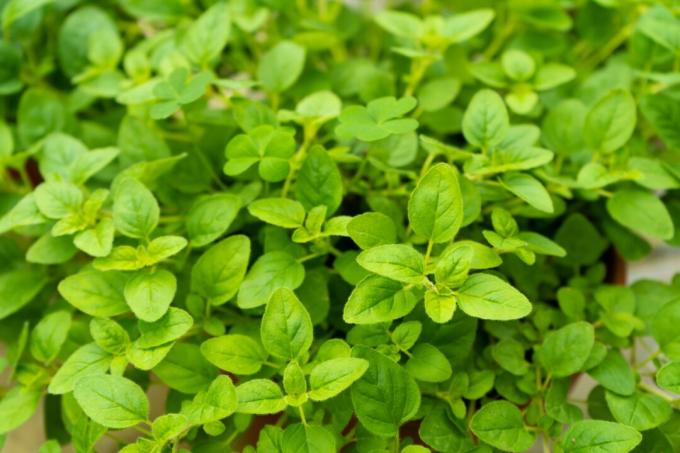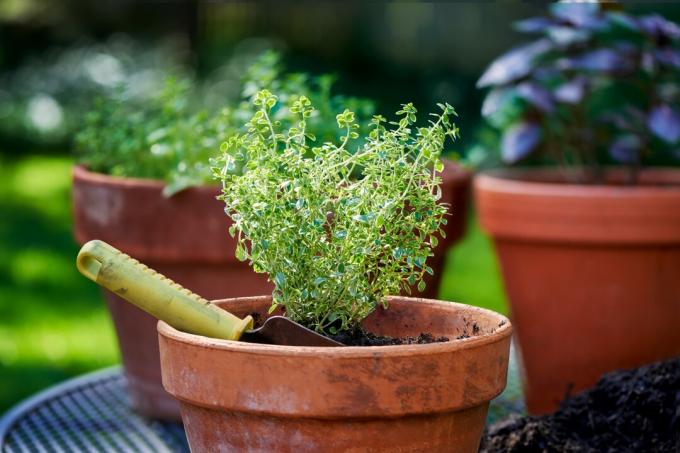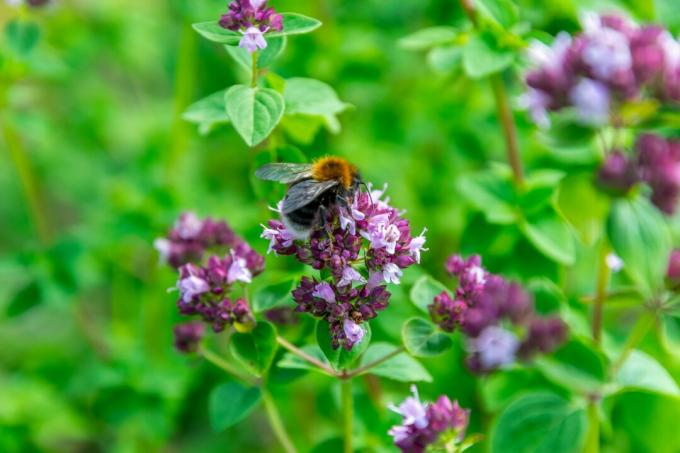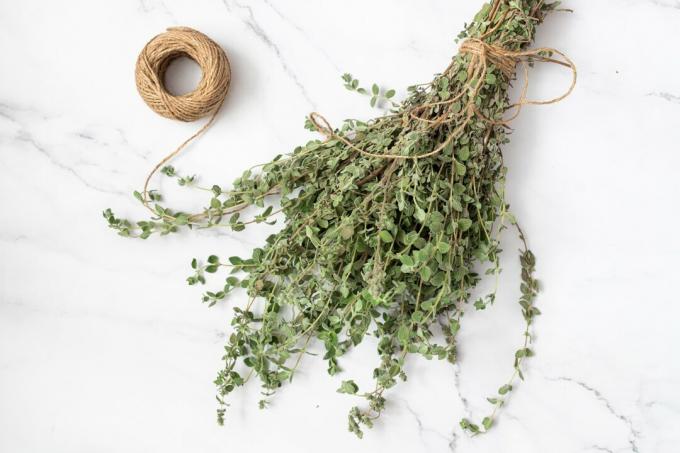Marjoram can be used in many ways as a powerful spice in the kitchen. Here's everything you need to know about the herb.

Marjoram (Origanum majorana) is a mint (Lamiaceae), which is closely related to the oregano is (Origanum vulgare). However, there are some properties that make the Marjoram differs from the classic pizza herb. While oregano can be grown for several years due to its extensive winter hardiness, the marjoram usually leaves the garden before the cold temperatures. The herb, native to Asia Minor, found its way to Central Europe at an early stage. For the Greeks, marjoram symbolized happiness and was used as a necklace for newlyweds. In the Middle Ages, the herb was assigned not only healing properties for stomach ailments and wounds, but also for psychological complaints and language disorders. In this country it is also called sausage cabbage, as it is used as a classic flavor component in many sausage recipes. In our regions, however, the temperatures are usually not conducive to overwintering cultivation. Everything else that needs to be considered when growing marjoram is explained in detail below so that nothing stands in the way of a rich harvest.
contents
-
Cultivation: marjoram in your own garden
- Location
- Multiplication
- Watering and fertilizing
- Maintain
- Marjoram: varieties and their properties
- Marjoram: harvest and store
- Use of marjoram
Cultivation: marjoram in your own garden
Location
According to its original origin (Cyprus and Anatolia), the marjoram prefers sunny locations. As with most herbs from more Mediterranean regions, the soil should be well drained. If the soil is too heavy (loam, clay), it is advisable to loosen it up with sand or pumice rock. A special herbal soil such as our peat-free Plantura is ideal Organic herb & sowing soil. Regular incorporation of organic matter such as compost or manure at the beginning of the year can also help loosen up heavy soils.
In our guide to the Growing of marjoram you will find all the important tips and tricks for your herb bed.
Multiplication
Marjoram can be propagated quickly and easily by sowing. The best way to do this is to raise the seedlings in the preculture on the windowsill and then (from mid-May) plant them outdoors or put them in pots in the garden. The month of March is best suited as a sowing date for this. However, if the seeds are to be planted outdoors, it can lead to frost-related failures if the seeds are scattered in the bed before the ice saints in mid-May. Germination takes place relatively quickly after 15 to 20 days when the temperature is constant around 18 ° C. It should also be noted that marjoram is a light germ. Therefore only press the seeds on and do not cover them with substrate. This can significantly delay germination or even prevent it entirely.

Watering and fertilizing
Marjoram is generally used to dry periods. However, an even and good water supply promotes growth. Especially in the young plant phase in the Growing pots on the windowsill, avoid dryness of the substrate. On the other hand, waterlogging must not occur, which in turn favors infection with life-threatening root fungi.
If the plants are planted in the bed, apart from the preparatory incorporation, mainly organic fertilizers such as our Plantura are required Organic universal fertilizer or from compost in the spring, do not fertilize.
Maintain
Marjoram is otherwise relatively easy to care for. An attractive growth habit can be kept upright with the harvest cut. If the herbs are to be cultivated for several years in our part of the world, this must be taken into account when choosing the variety. The hardy varieties, however, are usually much less intense in aroma.
More interesting facts, like you Caring for marjoram properly, You will find here.

Marjoram: varieties and their properties
The original form of marjoram is more or less hardy, but its aroma is relatively weak. That is why more intensive-tasting varieties are usually grown in this country, but these are not to be overwintered in the bed. We will introduce you to different varieties with their characteristic properties:
- ‚German marjoram‘: Conspicuous elongated inflorescence in the shape of an ear; less strong formation of leaf mass.
- ‚French marjoram‘: High-yielding and heavily branching with a short, compact inflorescence.
- ‚Gentile‘: Perennial but sensitive to frost; well suited for drying.
- ‚Italian marjoram‘: Robust variety with a strong aroma and relatively dark foliage.
- ‚Marjolaine‘: Annual, but well suited for growing in pots.
- ‚Tetrata‘: Early ripening variety with dark green foliage.
Ultimately, a suitable variety can be found for every garden that does justice to the balancing act between the two requirements of aroma intensity and winter hardiness.
Marjoram: harvest and store
When harvesting marjoram, the timing is crucial. If the flowers are harvested before or at the beginning of the energy-sapping formation, the best content of the flavoring essential oils can be achieved. The marjoram blooms from June to September, so that the main harvest should be at the beginning of June. The shoots are cut about 10 cm above the surface of the earth. This promotes the branching of the plant and there is still some leaf mass left to generate energy. The ornamental flowering is of course delayed significantly when the entire plant is harvested. Marjoram is a very fast-growing herb: three months after sowing, you can harvest abundantly.

In addition to the freshly harvested use of marjoram, the herb is also ideal for storage. The leaves can simply be frozen after the small hook. Depending on your needs, you can eat from your own supplies all year round with almost no loss of aroma. If small losses in flavor intensity can be tolerated, then drying the entire shoots is also an adequate method of preservation. After two weeks hung up in a dry place, the marjoram leaves, which are then stripped and hermetically sealed, can be used for several years. Furthermore, a marjoram oil can be produced very easily. The fresh shoots are simply placed in a container with olive oil. The aromatic herbal oil can then be used for salad dressings or for frying.
Use of marjoram
The characteristic aroma of marjoram is very popular in the kitchen. It is indispensable, especially in the preparation of meat specialties. It is not for nothing that it is also called sausage cabbage. Depending on the variety and the time of harvest, marjoram should be used cautiously due to its sometimes enormous flavor. In addition to meaty dishes, it also goes great with potatoes and hearty stews. He is also a member of what is probably the most famous herbal potpourris of the "Herbs of Provence".
In addition to being tasty in the kitchen, marjoram has also proven to be a medicinal herb. As an ointment it promotes wound healing, as a tea it helps with stomach ailments and colds. However, the use of marjoram for medicinal purposes should not be carried out for more than two weeks at a time. Otherwise headaches could be caused due to the intense essential oils.
Even if the marjoram lacks steadfastness in winter - the herbs and herbs still more than deserve a place in the bed or in the pot on the terrace.
more on the subject Harvest and storage of marjoram see this article.
